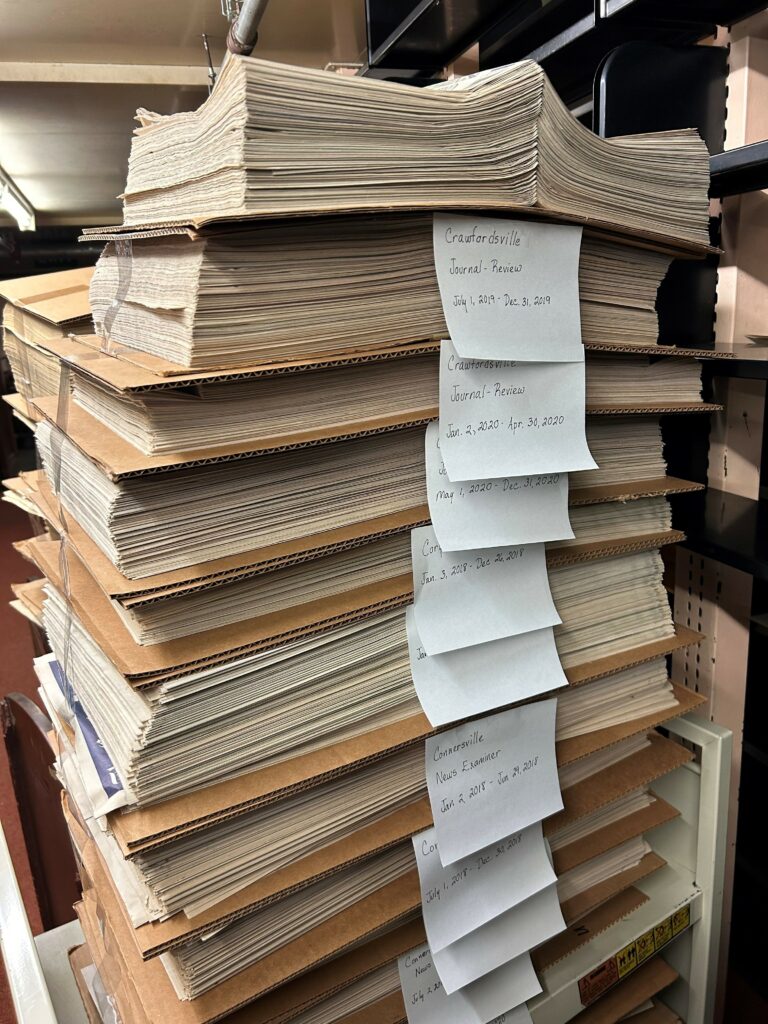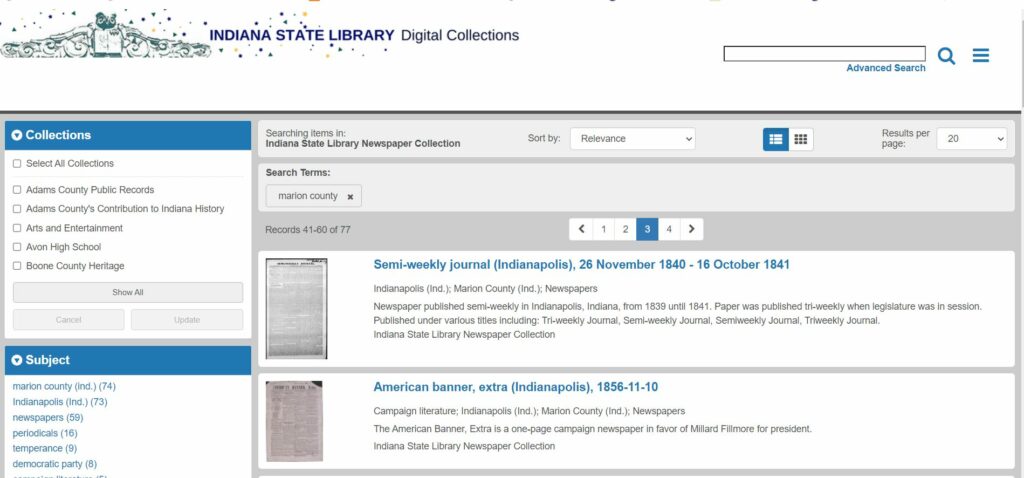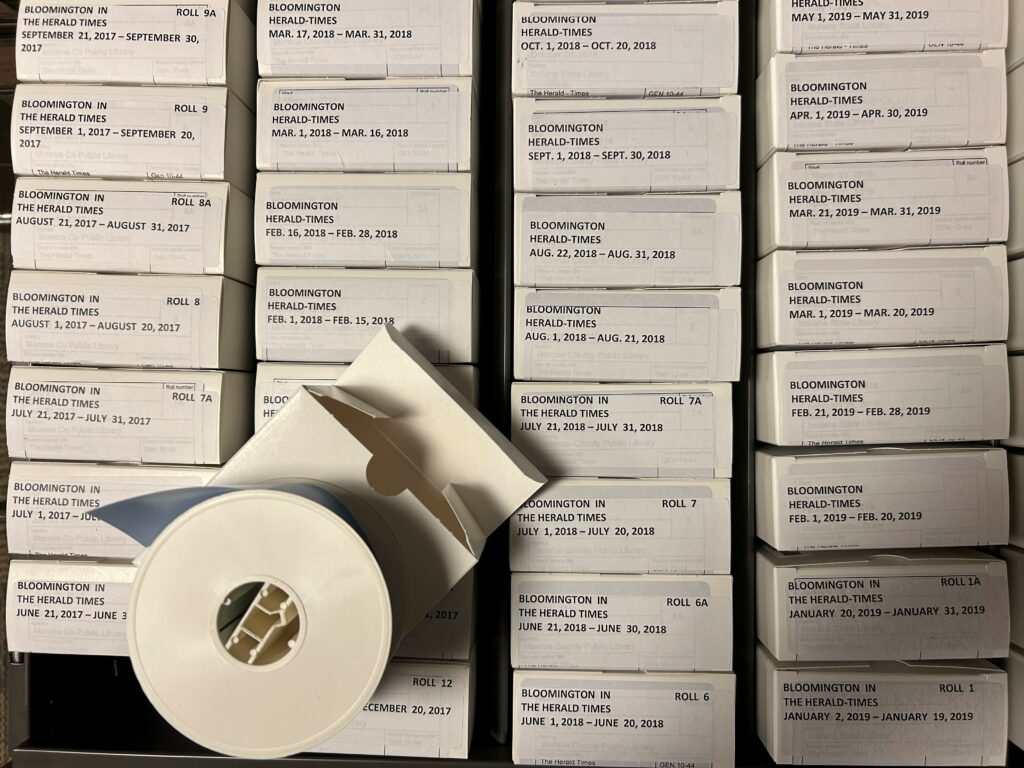Whether they exist in a society headquarters, a university, or a local library, archived newspapers require format diversity to be preserved effectively. At the Indiana State Library (ISL), newspaper titles can be stored as digital copies, print copies, and microfilm copies. Ensuring that each title is saved in two of these formats gives it “legs to stand on.”
Each preservation format has its benefits and drawbacks:
_______________________________________________________________________

Prints
The Positive: They are tangible objects that can be reliably stored with traditional taxonomy for easy access. Should a catastrophic computer virus or online attack occur, they will remain intact. Original prints retain the three-dimensional value of an artifact, in addition to the information contained on the pages. Finally, they won’t take up digital storage space.
The Negative: They will start degrading within a century, making scanning, filming, or any kind of handling difficult. They must be contained in an acid-free, cool, dry environment, in a location with enough physical space to hold them. Prints aren’t sharable instantly over long distances, nor will they withstand a catastrophic environmental event such as a fire. Prints cannot be automatically indexed for keywords.

Digital
The Positive: Using OCR (accessed via Adobe Acrobat at ISL), digital titles are keyword searchable. They are sharable instantly over long distances, particularly when included on database platforms. Compared to other formats, they use only minor amounts of physical storage space, in the form of USB drives and other devices. They can provide a very detailed copy, depending on the type of image version and file size. In the case of some current born-digital newspaper titles, they represent the original publication.
The Negative: For some publishers, digital versions are licensed by vendors that have a monopoly on film or database copies. In these cases, permission must be obtained to create preservation copies. Newspaper titles in digital formats, such as TIFFS, PDFs, and JPEGs, must be updated over time to keep their viability. Such digital format types are also in danger of disappearing over time in the name of progress. Finally, an online attack, a virus on a common drive, or environment occurrence that affects devices can destroy them.

Film
The Positive: Microfilm titles are tangible objects that can be stored with traditional taxonomy for easy access. They can be shared through ILL systems from one library to another. The original master reels can last from a century (for the older versions) to over 200 years (for newer polyester versions), making film the longest-lasting format overall. Film takes up less physical space than prints (but more space than digital), and only requires updating after the film begins to age.
The Negative: Film requires both master versions and duplicate versions, and each requires physical space in the form of public cabinets (duplicates) and a cool, dry vault with shelving (masters). Older films can create harmful gases when they deteriorate. Films can survive an online/digital attack but not an environmental one, and they are not keyword searchable.
____________________________________________________________________________
Most libraries, universities, or societies that collect local (county or state) newspapers will generate these three formats through various relationships with other organizations. ISL works with another state government agency, the Indiana Archives and Records Administration (IARA) to have microfilms created, and also with the Hoosier State Press Association for digital Indiana titles on a hard drive. Older print newspapers are stored on three levels of vaults in the inner sanctum of the building, while more recent print newspapers are saved on film before being discarded. To follow the two-format preservation rule, these current print newspapers will eventually require digital preservation. If the occasion arises that all local newspapers are published digitally, film can provide the second copy format.
Does your institution use format diversity for newspapers? What formats and partnerships are available to you?
_________________________________________________________________
Find Out More About ISL Newspaper Holdings
To see what ISL holds in print:
Original Print Indianapolis Newspaper Holdings
Original Print Non-Indianapolis Newspaper Holdings
To search our digitized newspaper initiative, visit Hoosier State Chronicles:
https://newspapers.library.in.gov
To see our microfilm holdings:
https://digital.statelib.lib.in.us/legacy/search.aspx?index=6
